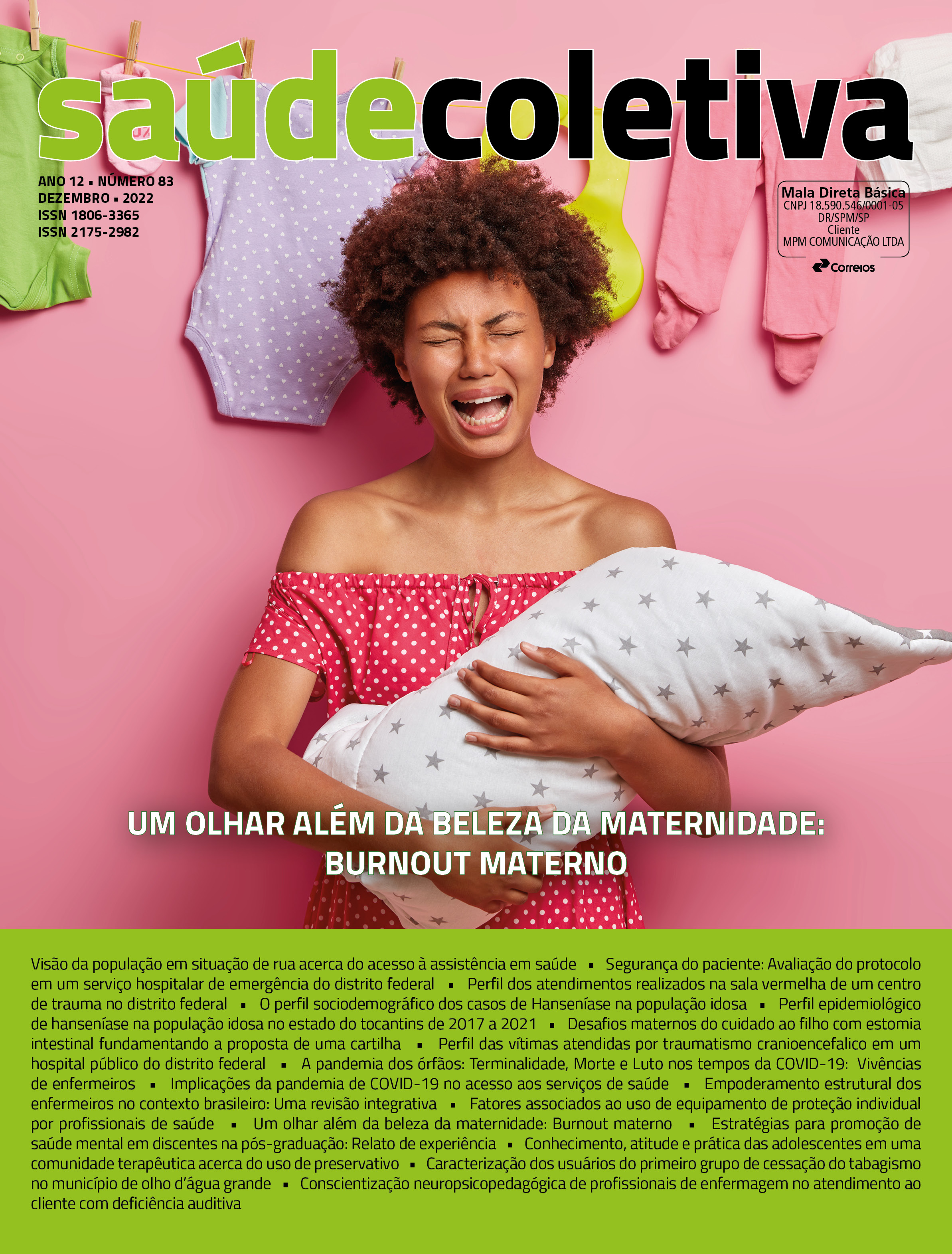Profile of services performed in the red room of a trauma center in the federal district
DOI:
https://doi.org/10.36489/saudecoletiva.2022v12i83p11996-12009Keywords:
Health profile, Hospital assistance, Emergencynursing, Hospital rapid response teamAbstract
Objective:Todescribetheclinicalandepidemiological profile ofpatientstreated in a red trauma room in a public hospital in the Federal District. Methods:Quantitative, descriptive, cross-sectionalandanalyticalstudy, using data fromtheredroomadmissions book fromJanuary 2018 toJanuary 2019. Results:Ofthe 456 patientsseen, 77.2% were male, mean age 37 years, 34% arrivedatnight, 70.6% came fromurbanpublicroads, 37.9% arrivedbyambulancefromtheFireDepartment. 32.5% werereferredtotheoperatingroom, 16.2% werevictimsofbeingrun over and 32.7% withTraumaticBrainInjury. Ofthescalesthatwerepossibletobeevaluated, 41.9% obtained grade 8 withanaverageof 6 points. Conclusion:Traumaticbraininjurywasthemostprevalentinjury/disease, andthemost common clinicaloutcomewasreferraltotheoperatingroom. The informationfound in thisresearchis in accordancewiththeBrazilian reality confirmedbytheliterature.
References
Silva HCet al. Trauma in elderly people: access to the health system through prehospital care. Rev latino-amenferm. 2016.
Organização Mundial de Saúde. Carga global de doenças. Disponível em: . Acesso em: 30 de set. 2022.
Brasil. Ministério da Saúde. Transição demográfica e epidemiológica: a Epidemiologia e Serviços de Saúde revisita e atualiza o tema. Epidemiol. Serv. Saúde. v. 21, n.4, p.529-532, out.-dez., 2012.
Oliveira SN, Ramos BJet al. EmergencyCareUnits (Upa) 24h: The Nurses’ Perception. Texto &contextenferm. 2015
BRASIL. Ministério da Saúde. Sistema de informações sobre mortalidade. Disponivel em: <http://www2.datasus.gov.br/DATASUS/index.php?area=0203>. Acesso em: 27 nov. 2020
Brasil. Ministério da Saúde. Plano de ação regional da rede de atenção às urgências e emergências do distrito federal. Brasília, 2018.
Domingues CAet al. Desempenho dos ajustes do Trauma andInjurySeverity Score (TRISS): revisão integrativa. RevEscEnferm USP. 2015;49(Esp):138-46.
Alvarez BD et al. Avaliação do Escore de Trauma Revisado (RTS) em 200 vítimas de trauma com mecanismos diferentes. RevColBrasCir, v. 43, n. 5, p. 334-40, 2016.
Rodrigues AIG et al. Perfil dos usuários atendidos no serviço de emergência em um hospital universitário em Pernambuco. Revista Baiana de Saúde Pública, v. 39, n. 1, p. 13, 2015.
Maia PKS. Perfil das vítimas atendidas pelo serviço aeromédico do Corpo de Bombeiros Militar do Distrito Federal. 2015.
Praça WR. Vítimas de trauma no DF: perfil epidemiológico e atendimento pré e intra-hospitalar pelo SAMU. 2015.
Cunha EC, Melo LFM. Perfil epidemiológico de motociclista atendido por trauma cranioencefálico na Sala Amarela-Hospital Referência ao Trauma do Distrito Federal. Comunicação em Ciências da Saúde, 2019.
Soares EP, Scherer MDA,O'dwyerG. Inserção de um hospital de grande porte na Rede de Urgências e Emergências da região Centro-Oeste. Saúde em Debate, v. 39, p. 616-626, 2015.
Slaviero RS et al. Perfil epidemiológico dos pacientes atendidos no período de 2014 a 2016 pelo serviço de transporte aeromédico interhospitalar vinculado ao consórcio intermunicipal samu oeste, como parte integrante da rede paraná urgência. Revista Thêma et Scientia, v. 7, n. 2E, p. 206-222, 2017.
Costa ACC, Fortes RC. Principais intercorrências e desfechos clínicos de idosos vítimas de trauma na unidade de terapia intensiva. CogitareEnferm., 2018.
Freitas MG. et al. Elderly patients attended in emergency health services in Brazil: a study for victims of falls and traffic accidents. Ciência & Saúde Coletiva, v. 20, p. 701-712, 2015.
Santos F et al. Traumatismo cranioencefálico: causas e perfil das vítimas atendidas no pronto-socorro de Pelotas/ Rio Grande do Sul, Brasil. REME – Rev Min Enferm. 2013 out/dez. v. 17, n. 4, pp. 882-887.
Venturini DA, Marconi SS. Anotações de enfermagem em uma unidade cirúrgica de um hospital escola. RevBrasEnferm, Brasília 2008 set-out; 61(5): 570-5.







